Enhancing Ice Nucleation: The Role of Surface Roughness in Electrofreezing Using Laser Shock Processed Al6061 T6 Electrodes
Abstract
:1. Introduction
2. Materials and Methods
2.1. Electrofreezing Experiment
2.2. The Electrode Treatments
2.3. Microstructure and Crystalline State
2.4. Roughness Measurements
3. The Effect of Pulse Density on the Surface Structuring
4. Results and Discussion
4.1. The Effect of Pulse Density on Electrode Roughness
4.2. The Effect of the LSP Process on the Crystalline State of the Electrodes
4.3. The Effect of the LSP Treatment with Different Pulse Densities on Nucleation Temperature as a Function of High DC Voltage
5. Conclusions
Author Contributions
Funding
Institutional Review Board Statement
Informed Consent Statement
Data Availability Statement
Acknowledgments
Conflicts of Interest
References
- Braslavsky, I.; Lipson, S.G. Electrofreezing Effect and Nucleation of Ice Crystals in Free Growth Experiments. Appl. Phys. Lett. 1998, 72, 264–266. [Google Scholar] [CrossRef]
- Jha, P.K.; Xanthakis, E.; Jury, V.; Havet, M.; Le-Bail, A. Advances of Electro-Freezing in Food Processing. Curr. Opin. Food Sci. 2018, 23, 85–89. [Google Scholar] [CrossRef]
- Smith, M.H.; Griffiths, R.F.; Latham, J. The Freezing of Raindrops Falling through Strong Electric Fields. Quart. J. Roy. Meteor. Soc. 1971, 97, 495–505. [Google Scholar] [CrossRef]
- Hozumi, T.; Saito, A.; Okawa, S.; Watanabe, K. Effects of Electrode Materials on Freezing of Supercooled Water in Electric Freeze Control. Int. J. Refrig. 2003, 26, 537–542. [Google Scholar] [CrossRef]
- Sanz, P.D.; de Elvira, C.; Martino, M.; Zaritzky, N.; Otero, L.; Carrasco, J.A. Freezing Rate Simulation as an Aid to Reducing Crystallization Damage in Foods. Meat Sci. 1999, 52, 275–278. [Google Scholar] [CrossRef] [PubMed]
- Deng, Q.; Wang, H.; Zhou, X.; Xie, Z.; Tian, Y.; Zhu, X.; Chen, R.; Ding, Y.; Liao, Q. Microstructure Enhances the Local Electric Field and Promotes Water Freezing. Ind. Eng. Chem. Res. 2022, 61, 11777–11789. [Google Scholar] [CrossRef]
- Dyer, K.; Ghadar, S.; Zulić, S.; Rostohar, D.; Asadi, E.; Molaei, R. The Effect of Laser Shock Peening (LSP) on the Surface Roughness and Fatigue Behavior of Additively Manufactured Ti-6Al-4V Alloy. Coat. World 2024, 14, 110. [Google Scholar] [CrossRef]
- Yadav, M.J.; Jinoop, A.N.; Danduk, C.; Subbu, S.K. Laser Shock Processing: Process Physics, Parameters, and Applications. Mater. Today Proc. 2017, 4, 7921–7930. [Google Scholar] [CrossRef]
- Fabbro, R.; Peyre, P.; Berthe, L.; Sollier, A.; Bartnicki, E. Physics and Applications of Laser Shock Processing of Materials. In High-Power Lasers in Manufacturing; SPIE: Osaka, Japan, 2000; Volume 3888, pp. 155–164. [Google Scholar]
- Xanthakis, E.; Havet, M.; Chevallier, S.; Abadie, J.; Le-Bail, A. Effect of Static Electric Field on Ice Crystal Size Reduction during Freezing of Pork Meat. Innov. Food Sci. Emerg. Technol. 2013, 20, 115–120. [Google Scholar] [CrossRef]
- Acharya, P.V.; Bahadur, V. Fundamental Interfacial Mechanisms Underlying Electrofreezing. Adv. Colloid Interface Sci. 2018, 251, 26–43. [Google Scholar] [CrossRef] [PubMed]
- Orlowska, M.; Havet, M.; Le-Bail, A. Controlled Ice Nucleation under High Voltage DC Electrostatic Field Conditions. Food Res. Int. 2009, 42, 879–884. [Google Scholar] [CrossRef]
- Dufour, L. Ueber das Gefrieren des Wassers und über die Bildung des Hagels. Ann. Der Phys. 1862, 190, 530–554. [Google Scholar] [CrossRef]
- Salt, R.W. Effect of Electrostatic Field on Freezing of Supercooled Water and Insects. Science 1961, 133, 458–459. [Google Scholar] [CrossRef] [PubMed]
- Hans, R.P. The effect of an external electric field on the supercooling of water drops. J. Geophys. Res. 1963, 68, 4463–4474. [Google Scholar] [CrossRef]
- Shichiri, T.; Nagata, T. Effect of Electric Currents on the Nucleation of Ice Crystals in the Melt. J. Cryst. Growth 1981, 54, 207–210. [Google Scholar] [CrossRef]
- Shevkunov, S.V.; Vegiri, A. Electric Field Induced Transitions in Water Clusters. J. Mol. Struct. Theo. Chem. 2002, 593, 19–32. [Google Scholar] [CrossRef]
- Chang, K.T.; Weng, C.I. The Effect of an External Electric Field on the Structure of Liquid Water Using Molecular Dynamics Simulations. Chem. Phys. 1999, 244, 331–337. [Google Scholar]
- ISO 21920-2:2021; Geometrical Product Specifications (GPS)—Surface Texture: Profile. Part 2: Terms, Definitions and Surface Texture Parameters. ISO: Geneva, Switzerland, 2021.
- Sánchez-Santana, U.; Rubio-González, C.; Gomez-Rosas, G.; Ocaña, J.L.; Molpeceres, C.; Porro, J.; Morales, M. Wear and Friction of 6061-T6 Aluminum Alloy Treated by Laser Shock Processing. Wear 2006, 260, 847–854. [Google Scholar] [CrossRef]
- Dhakal, B.; Swaroop, S. Effect of Laser Shock Peening on Mechanical and Microstructural Aspects of 6061-T6 Aluminum Alloy. J. Mater. Process. Technol. 2020, 282, 116640. [Google Scholar] [CrossRef]
- Salimianrizi, A.; Foroozmehr, E.; Badrossamay, M.; Farrokhpour, H. Effect of Laser Shock Peening on Surface Properties and Residual Stress of Al6061-T6. Opt. Lasers Eng. 2016, 77, 112–117. [Google Scholar] [CrossRef]

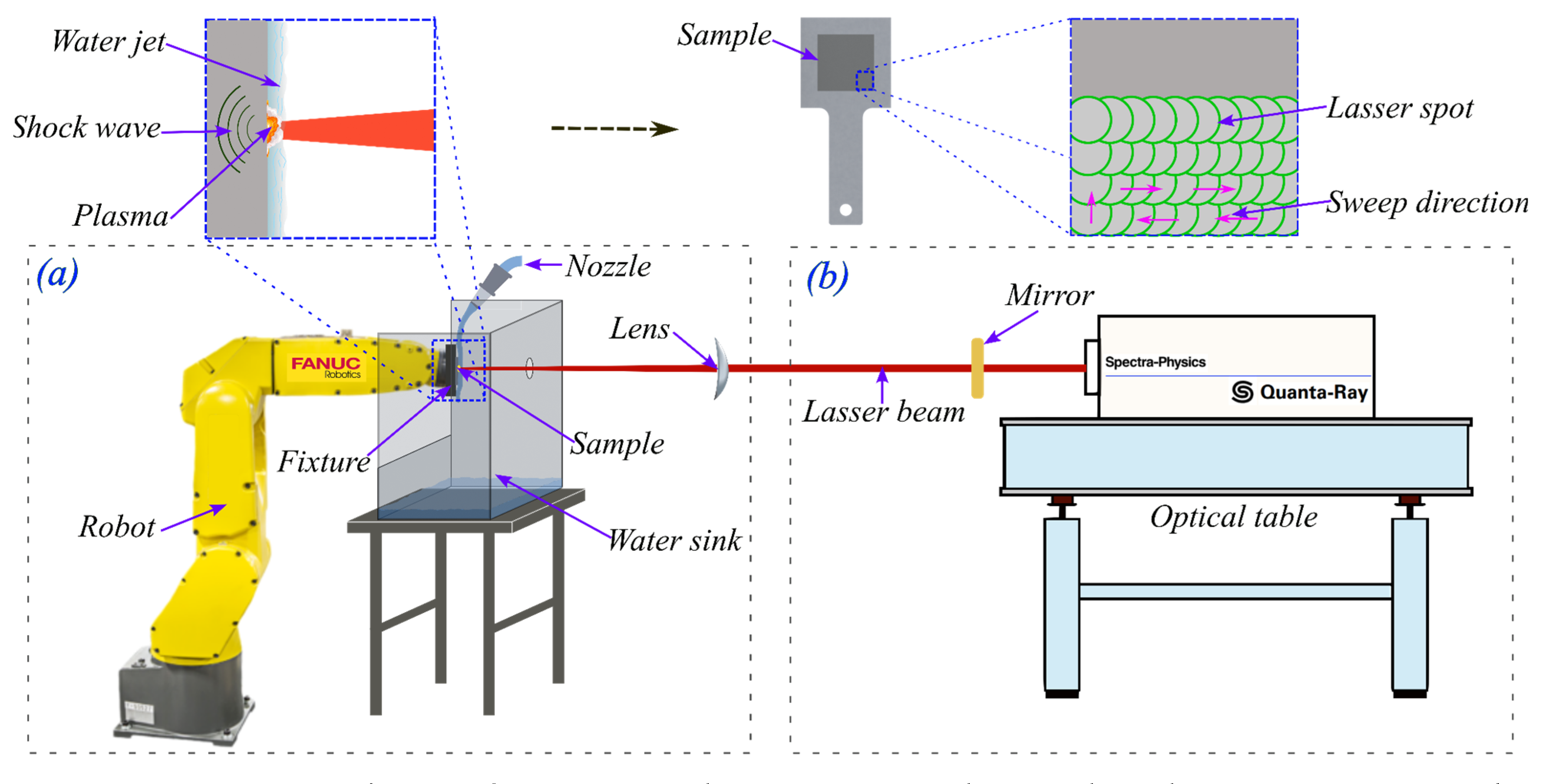


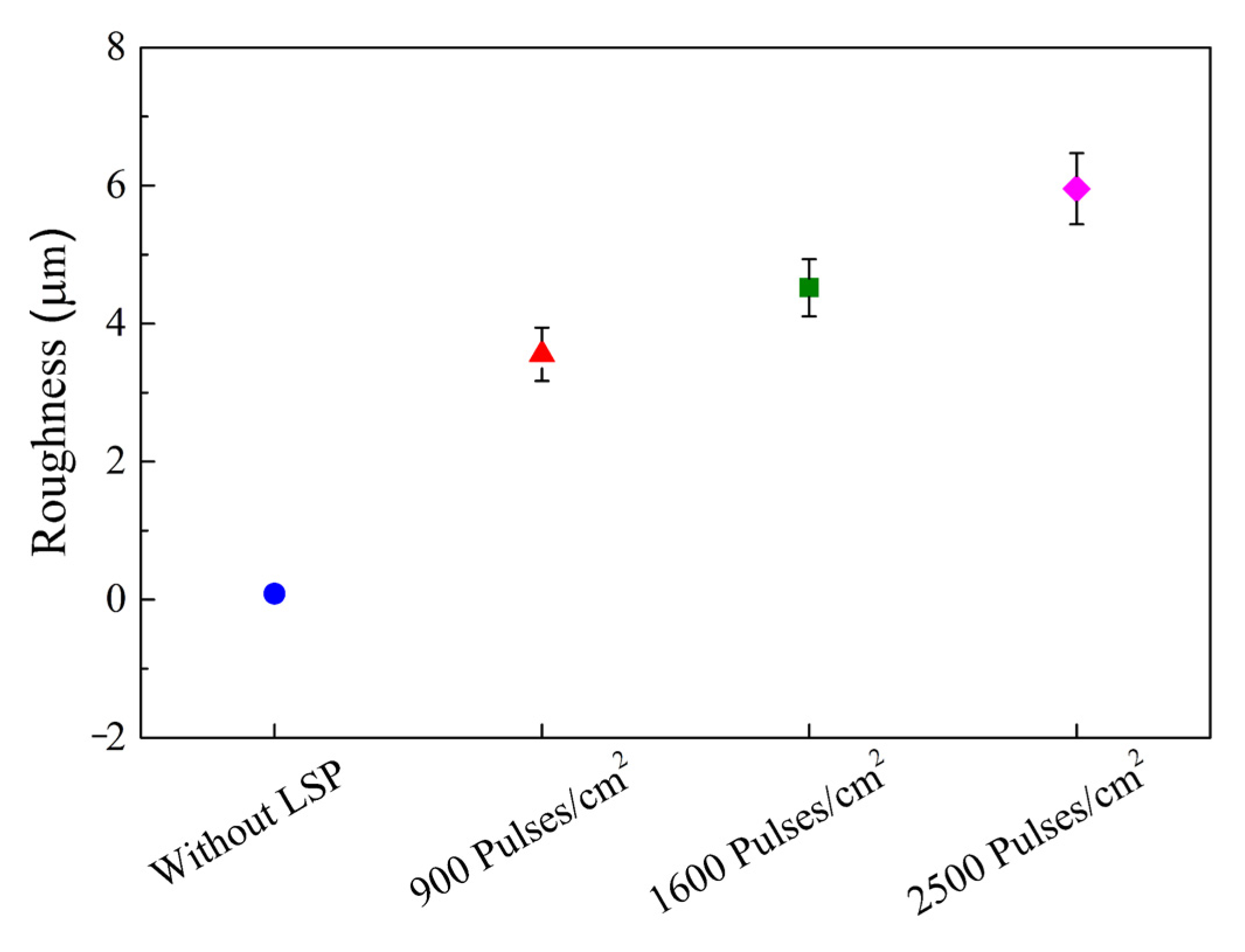

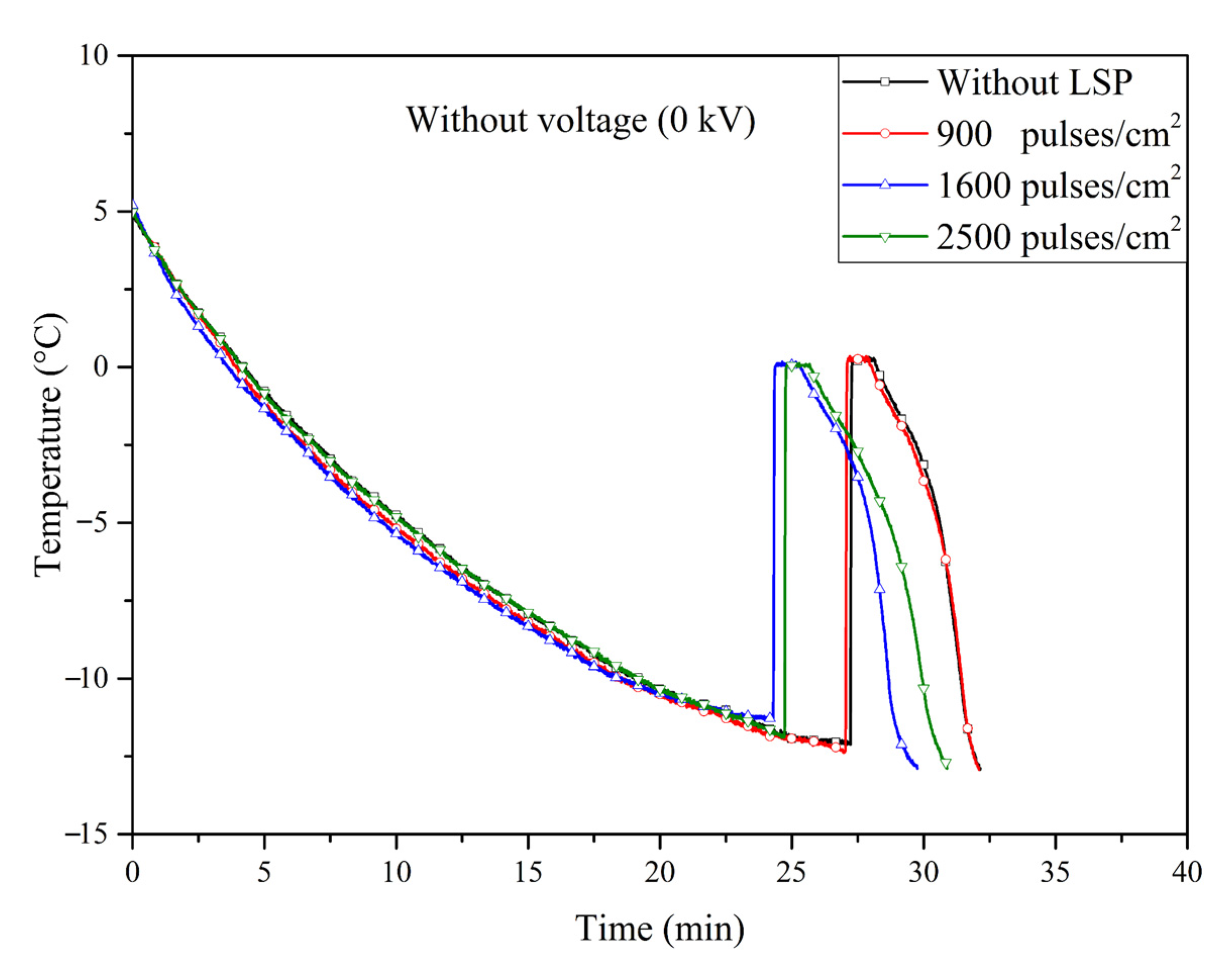

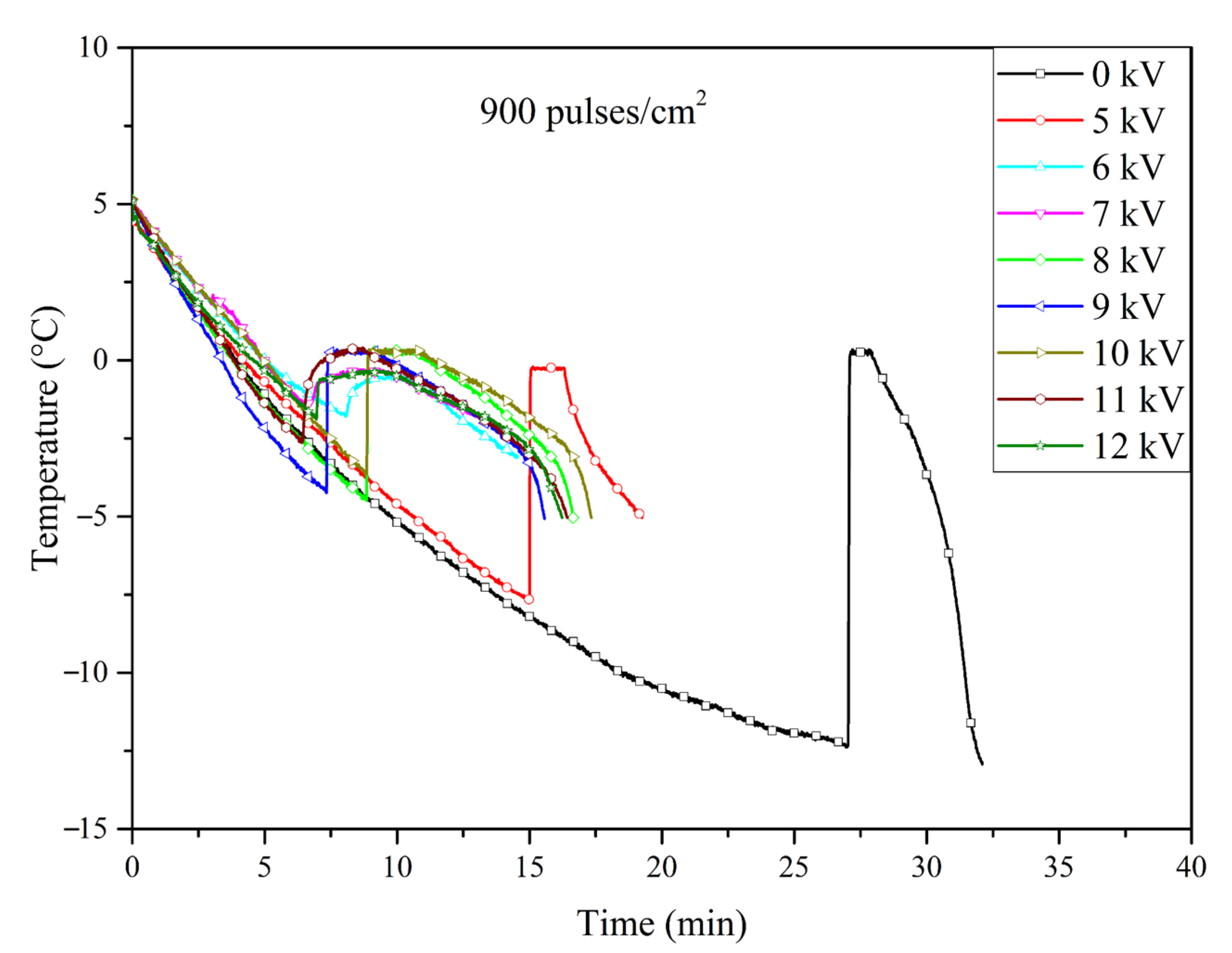

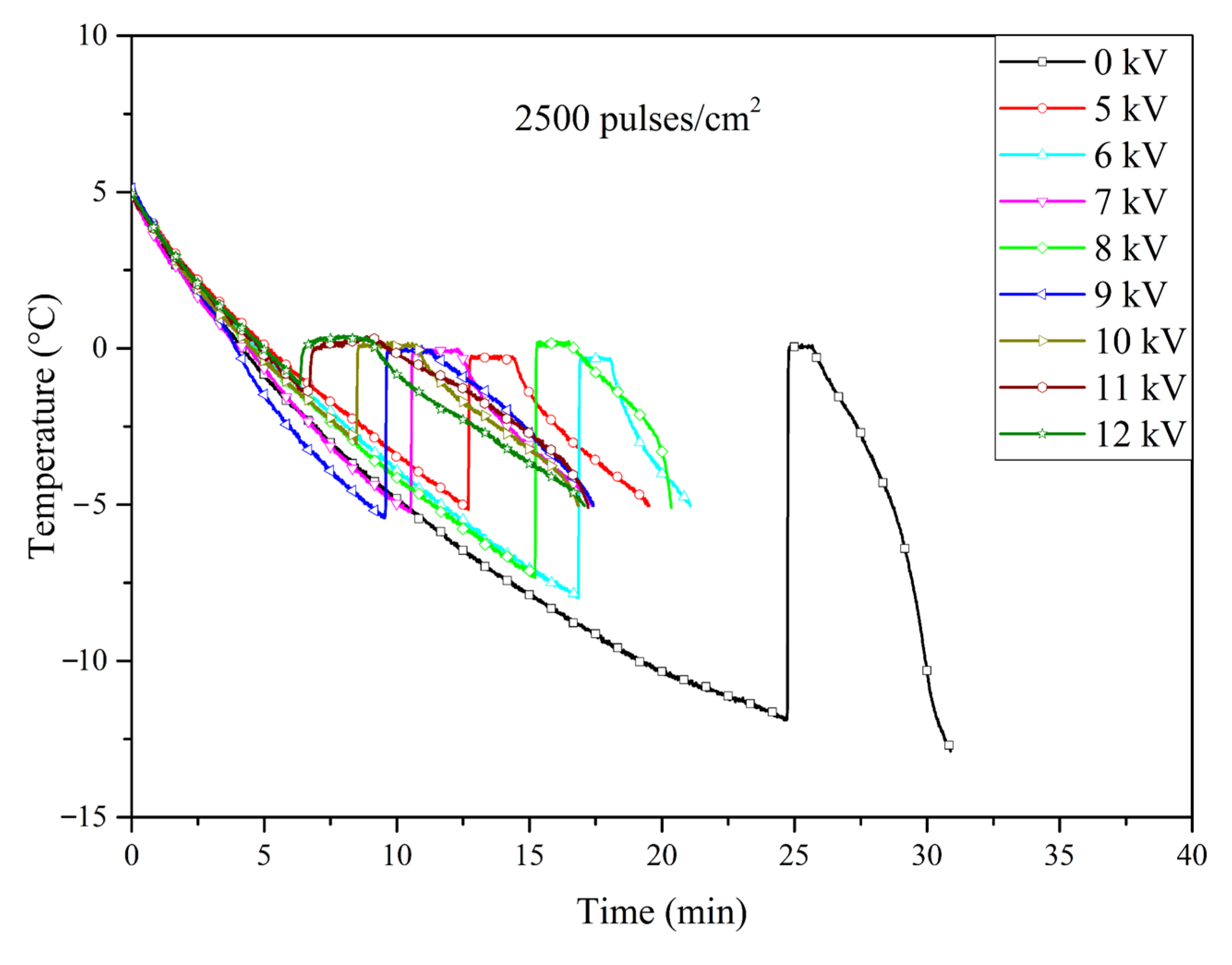

| Nucleation Temperature °C | |||||||||
|---|---|---|---|---|---|---|---|---|---|
| Electrodes | Voltage | ||||||||
| 0 | 5 kV | 6 kV | 7 kV | 8 kV | 9 kV | 10 kV | 11 kV | 12 kV | |
| 0 pulses/cm2 | −12.118 | −9.395 | −7.301 | −5.642 | −3.755 | −4.809 | −3.304 | −1.861 | −1.98 |
| 900 pulses/cm2 | −12.370 | −7.623 | −1.801 | −1.450 | −4.488 | −4.237 | −3.655 | −2.632 | −1.891 |
| 1600 pulses/cm2 | −11.31 | −5.07 | −4.23 | −2.09 | −4.718 | −4.207 | −3.755 | −2.542 | −1.831 |
| 2500 pulses/cm2 | −11.886 | −5.16 | −7.975 | −5.23 | −7.331 | −5.42 | −3.053 | −1.45 | −1.14 |
Disclaimer/Publisher’s Note: The statements, opinions and data contained in all publications are solely those of the individual author(s) and contributor(s) and not of MDPI and/or the editor(s). MDPI and/or the editor(s) disclaim responsibility for any injury to people or property resulting from any ideas, methods, instructions or products referred to in the content. |
© 2024 by the authors. Licensee MDPI, Basel, Switzerland. This article is an open access article distributed under the terms and conditions of the Creative Commons Attribution (CC BY) license (https://creativecommons.org/licenses/by/4.0/).
Share and Cite
Espinosa-Yañez, E.G.; Mondragón-Rodríguez, G.C.; José-Trujillo, E.; Luis, D.P. Enhancing Ice Nucleation: The Role of Surface Roughness in Electrofreezing Using Laser Shock Processed Al6061 T6 Electrodes. Appl. Sci. 2024, 14, 9145. https://doi.org/10.3390/app14199145
Espinosa-Yañez EG, Mondragón-Rodríguez GC, José-Trujillo E, Luis DP. Enhancing Ice Nucleation: The Role of Surface Roughness in Electrofreezing Using Laser Shock Processed Al6061 T6 Electrodes. Applied Sciences. 2024; 14(19):9145. https://doi.org/10.3390/app14199145
Chicago/Turabian StyleEspinosa-Yañez, E. G., G. C. Mondragón-Rodríguez, E. José-Trujillo, and D. P. Luis. 2024. "Enhancing Ice Nucleation: The Role of Surface Roughness in Electrofreezing Using Laser Shock Processed Al6061 T6 Electrodes" Applied Sciences 14, no. 19: 9145. https://doi.org/10.3390/app14199145





